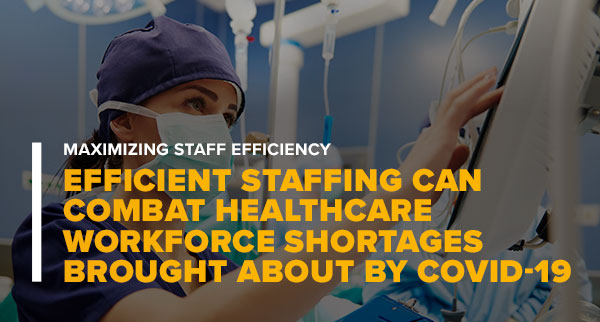By Jeff Lagasse - Published in Healthcare Finance - These are difficult times when it comes to healthcare staffing. Figuring out where to allocate personnel is a challenge even in normal times, but with the COVID-19 pandemic stretching the system to its breaking point, achieving both efficiency and quality patient care is requiring hospitals and health systems to tighten up their staffing processes. Many have to do it on the fly.
"Turmoil" sums up the situation succinctly, unfortunately, and in healthcare turmoil begets turmoil.
It's important for healthcare facilities to take a step back, reassess their labor needs and develop a proactive response to staff shortages. The topic of labor management in healthcare isn't new, but coronavirus surges have brought attention to the need for hospitals to take a proactive approach.
Mark Heymann, a labor expert and CEO of staffing company UniFocus, said the pandemic has created a deluge of patients, with many hospitals and health systems running at close to 100% occupancy. That, of course, means the staffing demands are different.
"Basically, as we all know, we're in a crisis mode every day," said Heymann. "The better your staff planning and the better your allocation of resources, the better shot you have at success."
Efficient staff planning in the age of COVID-19 largely entails deploying the right people to the right situations, and maximizing team members' skill sets. Take skilled nurses and physicians' assistants. Oftentimes, said Heymann, these professionals are dispatched to handle patients and cases that could potentially be handled by someone with less robust qualifications. By sending in a slightly less skilled staff member to tend to the simpler cases, skilled nurses and PAs are freed up to handle more complicated patients and scenarios.
"We have these resources being used, and their skill levels are being underutilized," said Heymann. "It's about rethinking what skills are necessary to accomplish which tasks."
UNDERSTANDING THE PATIENT
But in order to determine staff allocation, it first helps to understand the patients themselves. Hospitals and health systems that treat each patient as if they're the same tend to lose that business to other organizations. Only by understanding each patient as an individual, by having a handle on what their unique needs are, can a healthcare organization make the most of its workforce.
"Patients are not a homogenous group," said Heymann. "Patient A may have certain care requirements, and patient B, C and D may be slightly different. Good planning and labor use approaches can account for those nuances to ensure patients are getting the best care possible."
A good place to start is by conducting a census of the patients. Whether they're ambulatory or nonambulatory, have pulmonary or cardiac needs, each patient has a unique profile, and having access to a profile of sorts gives health systems the ability to predict what a certain patient is going to need for care, including periodically throughout the day. That in turn helps an organization know what their labor needs are, and allows them to break staff down by skill set for more informed deployment.
skill level. Bonus points if they can secure a full database of all the staff and their skills and qualifications. Producing weekly and daily schedules for the staff becomes much easier at that point, especially if the hospital or health system is fortunate enough to have some form of automation technology.
"When you get a match between the skill levels of the staff and the needs of the patients, there's a higher level of satisfaction on both sides, because the caregiver wants to give the best care possible," said Heymann. "But if you're in an understaffed situation it's difficult for that caregiver to do everything they can for the patient. When you're right-staffed, you know you can deliver the care necessary to drive high levels of satisfaction."
That may well pay dividends down the road. When the public health crisis has finally passed, patients will remember where and whether they received quality care. Hospitals and health systems that get a handle on their staffing situations early on will be well positioned for a post-pandemic future.
"The simple reality is, this is going to become more and more a critical part of how healthcare systems operate, not only from an efficiency standpoint, but from the standpoint of patient care," said Heymann. "So many hospitals today have just been overwhelmed. People need to look at healthcare holistically. You have to look at the total impact that a very effective labor organization can bring."






